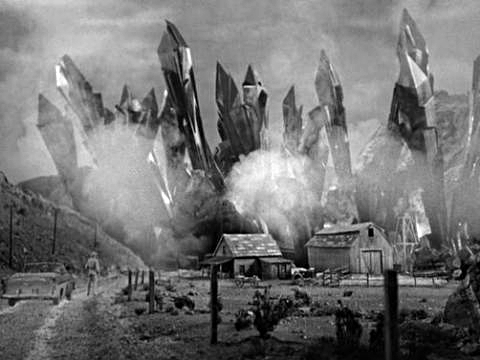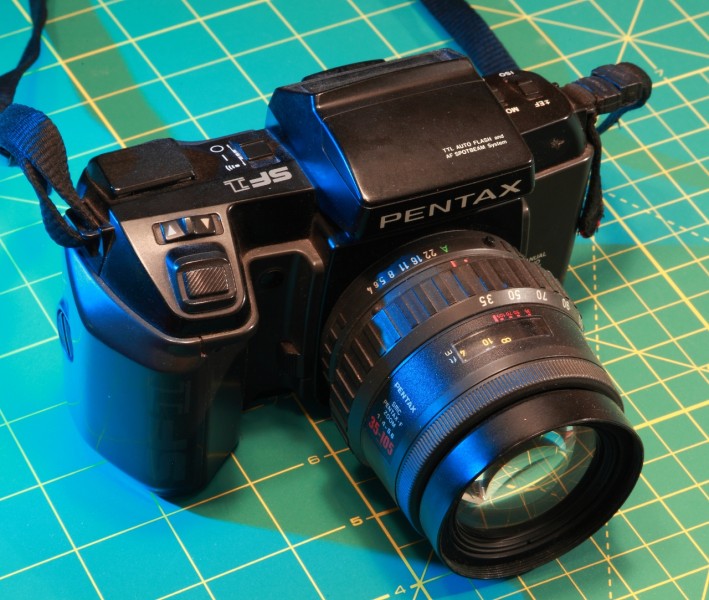Overlooked gems: The Monolith Monsters (1957)
(IMDB link) (Wikipedia link – contains spoilers)
A meteorite delivers silicate crystals with a composition not found on Earth, that grow at alarming speed when exposed to water and then fall over and shatter, advancing them across the terrain. Essentially a simplified ice-9 problem.
I like this film for two reasons. For one, it’s a science fiction with an unusually credible alien threat. The only presumption that falls outside known science is that such a substance could exist, and that’s enough to build a potentially world-threatening danger from. And given the amazing properties of some chemical reactions, it is easily believable.
Secondly, there are no stupid or venal characters. Everybody in the film behaves rationally and civilly and makes reasonable decisions based on the information they have. When someone needs convincing, it’s done easily by showing them the evidence. Nobody acts contrary to anyone’s best interests out of greed, vengeance or evil.
In short, deliberate stupidity and malevolence are contrivances not needed to artificially drive the plot. I am hard pressed to think of a movie made in the last three decades that didn’t rely on those things to create plot points. I am increasingly driven to review science fiction movies from the 50s and 60s because of this – it’s refreshing to see some actual competent writing that expresses confidence in humanity rather than the cynical mistrust so common today.
Oh, and for the era the special effects in this film are amazingly good. The sound design is excellent too.
What I’ve Been Watching
Europa Report – Above average science fiction, delivers what you want from this type of movie. Decent effects. Good acting and story. Slight over-reliance on simulated video transmission glitches.
Contagion – Not knowing what actual contagious disease control protocols are, this seemed a pretty reasonable dramatization of a new plague to me.
Dark Space – You know all those movies where some teenagers go off to a cabin in the woods for a weekend of partying, and mostly get killed by something there? This is that, in space. The nature of the danger is different from what I expected, and that made it a little more interesting. This is one of those “Nouveau B” movies that has decent CG effects that are undermined by bad compositing (typically the CG lighting doesn’t quite match the live footage) and what might be competent acting obscured in some scenes by bad foley (sound timbre or echoes that don’t match the setting).
Last Days on Mars – Pretty much the same as all the other zombies-on-Mars stories I’ve seen. Good production values.
Cargo – You know when someone signs on for a long haul on a corporation-run space ship, that corporation will turn out to be up to no good and it will cost a lot of lives. But this standard-trope tale was more well told than usual. Good effects, good acting, and best of all no reliance on blood and gore or spring-loaded cats.
The Haunted Palace – Another entry in my project to hunt down HP Lovecraft stories. This one claims to be based on both a Lovecraft story and an Edgar Allen Poe poem, though which specific ones are unstated. The main character’s name, Charles Dexter Ward, is taken from a Lovecraft story but there’s no strong correspondence with any of the Lovecraft stories I’ve read. Generally this is a pretty good flick though, as are most featuring Vincent Price. The only place it falls flat is in the creature effects department – using optical effects to try and suggest movement in what is clearly a statue.
Slime City Massacre – Pretty much what you’d expect. It starts out like a modern B-movie with bad effects, then turns into typical stalking monster fare.
The Hybrid – Quite enjoyable. The first half is decently suspenseful cloak & dagger stuff, and the rest is a science fiction splatterfest.
Going Clear: Scientology and the Prison of Belief – Documentary about the CoS. It’s well known that they’re dangerous crazies, but there is a lot of stuff covered in this film that I wasn’t aware of, that makes it even worse.
Avengers: Age of Ultron – Reasonably entertaining, though I don’t like how divergent it is from the mainstream origin story for Ultron.
Mad Max: Fury Road – Oh hell yes! I was looking forward to this so much I went back and re-watched all the previous Mad Max movies. I thought I might not like this one as much because it had a different lead actor, but he pulled it off satisfactorily. Though really it was Furiosa who was the star of the show. Rollicking good post-apocalyptic road warrioring fun!
Ex Machina – Entertaining and has a nice happy ending, but I wish it were possible to write this sort of story in such a way that it was entertaining AND made sense. The problem with this one, as is too often the case, is that some of the main characters (the two human ones) are morons, and have to be stupid for the plot to work. We’re let to believe through exposition that they’re both super geniuses, but they both overlook some rather basic flaws in their planning, and are very careless.
The Machine – Similar theme to Ex Machina but in a different setting and with different motivations. Still some stunningly stupid blind spots, this time on the part of the organization running the show.
Age of Ice – In the budding “father tries to save family from natural disaster” genre, and as seems typical of the genre the uptight, domineering, stupid asshollishness of the father proves to be more of a menace than the disaster itself. I tend to be pretty forgiving of bad movies but this is one of the rare ones that makes me resent the waste of time spent watching it. There is so much stupid and inexplicable dialog it feels like the script was written by a committee of infinite monkeys, and I wanted to strangle many of the characters much of the time. The CG effects are poor – no attention to detail (I spotted multiple copies of the same tree in some scenes, not even rotated relative to each other), and terrible compositing and lighting. Oh, and predictably the little kid’s video game obsession turns out to be a survival skill. That always happens when there’s a game-obsessed little kid in an adventure movie.
End of the Roll
I just finished shooting and scanning my last rolls of photographic film. I’m done shooting film for the foreseeable future, and am going fully digital. Granted those last four rolls have been sitting unused in my fridge for six or seven years already, but their presence bothered me and now that they’re done I have some closure.
With those last rolls out of the way, I also have closure on a project that turned out to be much larger than I expected: Scanning all my film into the computer. In my approximately 32 years of shooting film I amassed 300 rolls, for a total of just over 9,000 images. That may seem tiny compared to what a typical professional film photographer would have, but it takes up to three hours to scan each roll. This scanning job has been done in bits and pieces of my spare time over the last ten years, but if I had been doing it as a full-time job it would have taken me four months!
I bought a dedicated film scanner (Nikon Super CoolScan 5000ED) for this purpose ten years ago, hoping that its batch scanning workflow would help automate the process so I could do other things at the same time. It did, but the scanner software is so flaky that most of the time I got to do other things in parallel just because of the length of time it took to scan each negative; on average I had to scan each film strip image about 1.5 times because of software glitches. Also the batch mode only works for film strips and half my film is mounted slides – but at least scanning individual frames did not expose as many bugs in the software as strips. I considered upgrading to a newer scanner for the latter half of the project, but there were not enough technology improvements to justify the expense.
Anyway, that’s all done now. What’s left is the almost as huge task of cataloging and tagging all my photos. I put a fair bit of effort into researching DAM (Digital Asset Management) software a few years ago and decided on idImager, which appears to have since been rebranded Photo Supreme, as it met more of my requirements for a better price than anything else I looked at. I’ve tried it and quite like it; the tagging and versioning workflow is great, it has some nice bonus features too.
For the record, my 9,000 scanned film photos take up just over 1TB of disk space – I’ve scanned them at 4,800 dpi or higher in 48-bit color, and they don’t compress well because of film grain and sensor noise. A typical image is 120MB big.
I’m really happy to have the scanning project over and done with. That was a lot of work.
This seems like a good time for a retrospective on my personal history with film and film cameras.
When I was a child my mother shot black and white on her Yashica-Mat TLR, and did her own darkroom work. She sometimes let me help with the developing and showed me how to play with the projector to make contact images of household objects and toys – I think that’s where my initial interest came from. It’s magic to shine a light on paper and have a permanent image appear.
—
Keystone 110
The first camera of my own was a generic pocket-sized 110 camera from Consumers Distributing. It had a built-in permanent flash, two focal lengths and a neat in-viewfinder flash ready indicator that I always wondered at the operation of – it was a clever design feature, lighting up despite having no light built in to the indicator. I shot a lot of what I now call tourist/documentary photos on this unit – that is, photos of interesting places and things, but with very little artistic merit to the photos themselves. I was too young to have developed a sense of what makes a photo great, though towards the end of this camera’s long tenure I started experimenting with composition and with panoramas made by taping prints together.
I also used a couple of disposable 110 cameras and one of those ultra-tiny kids’ “spy cameras” from the comic ads, which fits in the gap in the middle of the 110 cartridge.
Examples of pictures I took with the 110:
—
The Polaroid
Later I had a Polaroid instant camera. It was cool to get the photos immediately and the color and clarity were much better than on the 110, but the film was relatively expensive per photo and even as a child I recognized the value of having negatives available for reprints and enlargements. The Polaroid didn’t see frequent use because of its limitations, but it did last a long time.
Examples of pictures I took with the Polaroid:
The Bellows Camera
Also during my tweens I had an old-fashioned bellows camera. I believe it was a Kodak Tourist II given to me by my mother, based on her notes on her own photos. I didn’t use it much and it didn’t make much of an impression on my memory. Eventually the bellows got too many light-permitting punctures for the camera to work well, so I followed nature’s directive and took it apart to see how it was made.
Examples of pictures I took with the bellows camera:
—
The Pink Camera
My first 35mm camera was a cheap fixed-focus tourist model. This was basically the same deal as my 110 but 35mm instead. I no longer remember even what brand it was, but it look vaguely like this only pink. I got quite a bit of use out of it and started to develop a better sense of composition during this time (most of my teens).
Examples of pictures I took with the pink camera:
—
Pentax ESII
For my 20th birthday my parents gave my first “real” (read SLR) camera, a Pentax ESII with a fast 50mm prime lens. This is the film camera I got the most mileage out of, developing my artistic skill and eventually amassing a small collection of used lenses for it. When the electronics eventually failed I bought a second one to replace it, and that’s the camera I just finished shooting some of my last rolls with. I also picked up a Pentax Spotmatic, which uses the same lenses, so I could have two bodies for shoots where I would want to swap lenses a lot. For a while I did my own B&W developing at home too. The Pentax was an excellent, life-altering gift. The vast majority of my film was shot with it and most of my photographic learning was done with it.
Example ESII & Spotmatic photos:
The Crap Pentax
In the early 2000s I picked up a more modern Pentax, used, because I was curious to see what an auto-focus, auto-winding, zoom-lensed camera was like. Unfortunately this model was a bad choice, as it felt cheap and I didn`t like using it. I think I only shot one or two rolls with it, and I no longer remember which ones they were so no examples for this one.
—
The TLR
A few years ago my mother gave me her old Yashica-Mat TLR medium format camera, as she has also gone digital. In the end I only shot a few rolls with it though. It’s a nice camera but I’m put off by the lack of a built-in light meter.
Example TLR photos:
—–
I’m not saying I’ll never shoot film again; it has its applications. But digital is so much cheaper and more convenient and a good digital SLR produces pictures that seem as good, and as enlargeable, as what I shot with my 35mm SLR.
One thing that film does have going for it is its variety of grains and color treatments. Simulating the heavy grain of some B&W films or the weird color cast of cheap 110 film with digital images just doesn’t look the same – at best it evokes nostalgia for those things in those what grew up with them.
I give it twenty years before I develop a weird nostalgia for shooting film and dig out the old cameras.
What I’ve Been Watching
Elysium: Disappointing second outing from Blomkamp. Great effects but pretty transparent and heavy-handed story obviously inspired by the whole “99%” thing. I liked District 9 better.
Ender’s Game: Would have made an OK TV series or movie series, but in a single movie it was far, far too condensed.
Gravity: Liked this one quite a lot. It’s a long series of highly improbably flukes of luck that lead to the main character surviving her ordeal, but aside from the luck part the rest seemed believable to me. Cinematography was great.
Interstellar: Best science fiction movie I’ve seen in a very long time. The sound mix was awful, with the music drowning out the dialogue in many places and some of the sound effects being painfully loud, but that’s pretty much my only complaint about it.
Oblivion: Meh. I’ll admit one of the plot twists did surprise me but it suffers from the same premise problem as most alien invasion flicks: Natural resources in general are easier to find out in space than to lift off a planet.
Riddick: Exactly what I expected: Vin Diesel’s “manly man” character being the same asshole he usually is, with lots of killing of people and creatures and highly improbable badassity. Disappointed in the creatures in this one – I liked the ones in Pitch Black better. Terrible movie but delivers what it promises.
The Colony: At least in this post-apocalyptic fight for survival humanity screwed up the weather directly, by building buggy weather control machines. The good guys’ quest in this flick is to find the one place where a working machine provides a habitable environment while avoiding back-stabbing cowards and a tribe of wandering cannibals. It’s mostly about people getting eaten or dying in noble self-sacrifice. Meh.
Hobbit part 3: Enjoyed it a lot, but it wasn’t quite as good as the previous two. I don’t remember the book very well as it’s been a very long time since I read it, but I think there’s enough divergence the movie should be “inspired by” the book and not “based on” it. The 3D worked, but as with the first movie the high frame rate gimmick broke immersion repeatedly – it looks less real at the higher frame rate.
The Doomsday Machine: Of course Chairman Mao would not only build a planet-buster but would also be crazy enough to use it. This one is about a last-ditch attempt to save the human race by getting a handful of men and women into space before the big one hits. The commander of the mission is an amazing asshole – basically a rapist whose intent becomes overt as soon as it becomes obvious their ship is on its own. He’s really, really, really creepy and surprisingly for the time this flick was made, it actually does admit that he is perhaps not the most upstanding person to have in command of a space mission. I feel like this one reused footage from a couple other similar movies of the time, and the ending was about as deus ex as it gets – it feels like they got to the last 30 seconds of the movie and suddenly realized they needed an ending.
After Earth: Exactly what I expected from the trailer, namely Will Smith and his son (both real and fictional) bonding through an ordeal on the hostile planet called… wait for it… Earth, and coming out of it a more functional family. Nothing wrong with the production though I was hoping for more creature effects, but I really have to wonder how much the production of this movie was intended to help the Smiths’ real-life relationship.
Automata: Liked this one a bunch. I’ll tentatively recommend this as one of the better science fiction movies of 2014. Not much I can say about it that isn’t either spoiler or covered by the synopsis.
Edge of Tomorrow: As an action flick it’s pretty good, but as science fiction it’s terrible. The main plot device is that the alien boss can rewind time, and will reset the day whenever one of its mini-bosses gets killed. OK, that’s not too bad, and the limitations on its time travel ability cover why it doesn’t just retcon its enemies out of existence. But here’s where it gets weird: The one who kills that mini-boss receives a fragment of the time control power – enough to be able to reset the day if he or she gets killed, and to remember what happened on all the previously retconned days, and to sense where the alien boss is located. I’m at a loss to explain how that’s supposed to work unless this time power is magic instead of technological.
But wait, it gets better: Somehow this time power resides in your blood, and the aliens can take it back from you by getting a sample of your blood. WTF? And then there’s this quantum physics gizmo that can partially reactivate the power after that if you jab your leg with the pointy end, because blood… what? Does Not Compute. The plot devices are so ludicrous that this movie is a flop as a science fiction.
Extraterrestrial: Straight-up UFO stuff. Teenagers, cabin in the woods, UFOs, greys, anal probes, government in cahoots with the aliens. Some blood and gore and one or two spring-loaded cats. I’ll give it credit for having the ending I thought less probable.
Hangar 10: You guise! I’ve got a GREAT IDEA!! Let’s do Blair Witch only with aliens instead of whatever was in that movie. That’s how the pitch for this one went, I’m sure. Now, I really really hate Blair Witch style shaky-cam cinematography, but even so I still watched it to the end and thought everything but the cinematography was moderately well done. There were a couple of scenes where I’m certain none of the characters could have been holding the camera, which is such an obvious flaw to look for in this sort of movie that I wouldn’t put it past some producers to add some deliberately as easter eggs. There were some surprisingly good visual effects at the end and I have to confess I didn’t fully understand what happened at the very end, but I’m OK with that – it’s usually better than exposition.
Her: Thoughtful and a good ending, but I found some of the interior romantic scenes uncomfortable. Glad I didn’t see this one with family.
In the Mouth of Madness: I’ve been on an HP Lovecraft reading binge lately and am now branching out to the few movies inspired by his works. Imagine my surprise to find one produced by John “The Thing” Carpenter! It was decent though not directly based on any of the HPL stories I’ve read. The main plot device was the idea that belief makes things real and that by inspiring enough belief, a horror fiction author could bring back the Elder Gods. Trouble with this is that the population figures quoted for this cult were below the numbers of at least three major religions, so there should have been proof of existence of their deities well in advance.
Lucy: The pain, the pain. This movie has Scarlett Johansson, Morgan Freeman and some decent effects, and that’s about it. The entire premise of the film is based on the long- and well-debunked myth that humans only use a small portion of their brain capacity. And somehow it gets from there to full-on mind over matter; Johansson’s character seems to become a Jean Grey scale telekinetic as a result of becoming superintelligent, which to me does not naturally follow. The movie ends up being a fast-paced power fantasy. If you want a decent movie about the emergence of super-intelligent individuals, skip this one and watch…
Limitless: An effective nootropic drug turns a wannabe author into an engine of effectiveness… until other people catch on and get their own supply of the drug. Liked this one all the way through, and recommend it.
The Dunwich Horror (1970): Another Lovecraft derivative. Too much of a departure from the original plot for my liking, though some of the characters were well acted. The creature effects, while not terrible considering when they were done, were also not what I expected to see.
The Signal (2014): Pretty decent SF though I saw the big reveal plot twist coming well in advance. Young crackers are lured to a remote location thinking they’re on the trail of a competing cracker, and instead end up involved with greys and Area 51 types and have to escape captivity and being experimented on.
Transcendence (2014): Not what I expected from the trailer, and I was very disappointed in its anti-transcendence slant though of course the cynic in me expected it; how often is it we get a pro-technology, pro-humanity science fiction flick? Much of the conflict in the story could have been avoided had the main character not made a couple of mistakes that are so stupid they belie the superintelligence we’re supposed to believe of him. And the ending was poor too; I can’t buy the happily reunited transcendent couple happily hiding out in their favorite garden when they could simply have left the planet and been unconstrained.
Under the Skin (2013-A): One of the artiest movies I’ve ever seen. If you like WTF nonsensical European low-budget science fiction art films then you’ll probably like this one, though the production values are pretty good here. What I liked most about this flick is there’s no exposition at all; it’s up to us to figure out what the story is and for the most part that’s not too hard, but the start and end are unresolved. We don’t really know how these events came to be or what the significance of the ending is. I’m OK with that. Liked it, but again I’ll warn you that there’s no neat bow tie on anything here and it may be unsatisfying.
Solaris: Book vs. Films
The 1972 film Solaris has long been one of my favorite science fiction movies. Mainly because of the concept of Solaris itself, but also because of the oddities of Russian filmmaking and its extreme length, both of which made the set of people who have watched it something of an elite club.
This last week, I finally set out to read the original book by Stanislaw Lem, and re-watch both of the films based on it. I had somehow never got around to reading the book before, and when I last saw the 1972 film I was too young to fully understand it. By the time of the 2002 film, I certainly understood it but was left with the feeling that it really diverged from the original vision, which is what prompted me to eventually do this comparison of the three.
There is a big difference. Lem was upset with the first film and I can see why. Both film adaptations use the trappings of the book to tell a different story, and largely miss what the book was about. The films are two different versions of the same love story, set in space, with Solaris simply being a setting that enables the strange situation of a man being confronted with what seems to be his dead wife, and all the mystery and angst that comes out of this apparent second chance.
I’m not saying the movies are bad. They’re both excellent films that tell engrossing and touching stories, but they’re not the original story. These are stories about people, which is fine since those tend to make for good movies, but they ignore the seven hundred billion ton elephant just outside the room.
Solaris, the book, was about questioning what humans as a race want from the universe. Science fiction is full of humans zipping around space, fighting and colonizing and meeting aliens and having a good time or getting eaten by monsters. Those are all pretty familiar and easy to understand things because they’ve happened on Earth in the past – we’ve gone zipping around the oceans, fighting and colonizing, meeting other flavors of humans and having a good time or getting eaten by tigers.
In Solaris we meet something truly alien – and what I love about Solaris is that it’s by far the most credible alien I’ve encountered in my life of reading the watching science fiction. Here’s a life form the size of a planet, larger than Earth. Apparently intelligent. Not an organism as we understand it – it’s not made of cells, but instead is a planetwide ocean of chemicals. Have you ever flown over the ocean and looked down at the endless deep water with its tiny waves? Imagine all that water was part of a giant brain. What commonality do we have with a being like that? How could we possibly communicate with it, and should we even bother trying?
Part of the setting in the book is about this – humans have been studying Solaris for decades already and making exactly zero progress. Solaris is certainly active – it reacts to their presence. It also manifests structures out of its soup, some of which appear to be models of things it knows about, including humans and mathematics, but these appear to be part of its thought process rather than communications. Human attempts at communication go nowhere – it may not know what communication is or may not have any motivation to communicate, or it may be trying to communicate and we just can’t recognize it.
After smacking their heads into this wall of alienness for so long, the characters in the story articulate how the communication effort reflects back on humanity: We don’t really know what to do with other planets and other beings, except convert them into more of the same – more Earths, more varieties of humans. The first time we run into something that can’t be hammered into any of the familiar pigeonholes, we don’t know what to do. The characters end up speculating to try and satisfy themselves, but it gains them no additional truth or understanding.
Best of all, there is no conclusion. Both of the movies have an ending that says what happens to the protagonist from then on, but the book is open-ended, and I prefer it that way. The story is meant to cause contemplation, and putting a bow tie on it removes the trigger for contemplation, which is the act of wondering what happens next.
I’m also disappointed that neither of the films attempt to render the visual richness of Solaris – making the films character stories certainly cut the effects budget by a lot. Solaris as described in the book is full of visual richness, with a wide variety of forms appearing on its surface ranging from barely comprehensible to completely incomprehensible. The hard science fiction nerd in me wants to see those things – I wanted a film about the what rather than the who. A future-documentary about Solaris would be just the thing.
To sum up, all three versions are great, but only the book is the true Solaris – the films are relatively pedestrian people stories in which the one truly special thing about the book is ignored and could be replaced with some other plot device, like a capricious wizard or standard little green men from Mars.


















